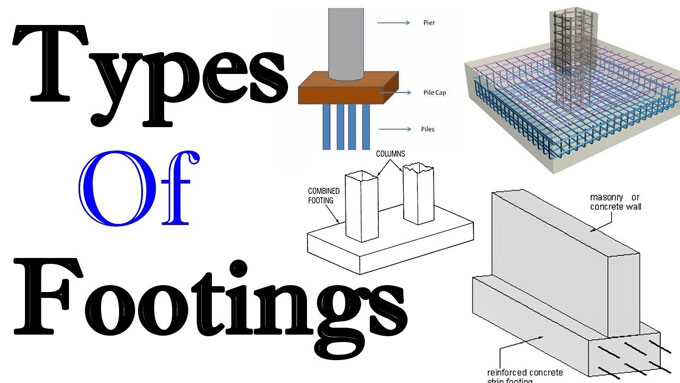
Commonly used footings in building construction

Footing is considered as one of the vital sections of a structure. It transmits the loads in a structure at the base of the soil. In order to choose perfect type of footing, the following factors should be taken into consideration.
1. The depth of the soil at which safe bearing strata is situated.
2. The type and condition of soil.
3. The type of the superstructure.
TYPES OF FOOTINGS - The following types of footings are found in building construction:
1. Wall footing/Strip footing.
2. Spread Footings
3. Isolated footings.
4. Stepped footings.
5. Combined footings.
6. Sloped footings.
7. Mat or Raft foundation.
8. Strapped footings
9. Pile foundation.
1. STRIP FOOTING: It is a section of shallow foundation that disperses the weight of a load bearing wall across the area of the ground. It is also called wall footing.
2. SPREAD FOOTING: Under this type of footing, a spread is provided under the base of the foundation to circulate the load of the structure to an extensive area of the soil in such a manner that the safe bearing strength of the soil is not surpassed.
3. ISOLATED FOOTING: This type of footing contains square, circular or individually rectangular slab with identical thickness. It is normally arranged under each column.
4. STEPPED FOOTING: This type of footing is mainly applied to retain the metal columns beyond direct contact with soil to protect them against corrosion. It is applied to bear the load of metal columns and transfer this load to the soil underneath.
5. COMBINED FOOTINGS: If two or more columns are supported with a footing it is known as combined footing. This footing is available in different shapes like rectangular or trapezoidal. Combined footing is arranged under following conditions.
a. If columns remain adjacent to each other and their individual footings are overlapped.
b. Soil contains low bearing strength and needs extra area under individual footing.
c. The column end exists adjacent to the property line and it is not possible to expand the footing.
6. STRAP FOOTING: In such footing, the outside and inside column is attached with a strap beam. It does not transmit any load to the soil. The individual footing areas of the columns are provided in such a manner that the C.G of the combined loads of the two columns move across the C.G of the two footing areas. As soon as this criterion is obtained, the pressure distribution under each individual footing will be consistent.
7. MAT FOUNDATION: This foundation covers the whole area under the structure. This foundation contains only RCC slab that covers the entire area or slab and beam jointly. Mat foundation is suitable if heavy structures should be erected on soft made-up ground or marshy sites with insecure behavior. Mat foundation is also called raft foundation.
8. SLOPED FOOTING: The footings with sloping top or side faces are called sloped footings. This type of footing can be applied in the construction of formwork.


